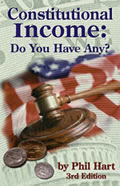Other
Ryter
Articles:
The Two Kerry's:
War Hero or
Traitor?
"Men in Black" The Cult of The Judges
DEBT
FOR TREES
PART 2
By Jon Christian Ryter
September 1, 2005
NewsWithViews.com
In 1999 Charles Hurwitz caved in and sold 10,000 acres of Headwaters Forest land to the Department of the Interior for $480 million. The deal was brokered by Sen. Diane Feinstein to preserve the old growth giant coastlal redwoods. In 2002 the FDIC dropped its 250 million action against Hurwitz when the OTM settled their $821 million case under an agreement where Hurwitz paid $206 thousand, made no admissions of wrongdoing, and agreed not to discuss the suit or the settlement.
But in his settlement, Hurwitz never agreed not to file suit against the government. He immediately sued the FDIC, by asking US District Court Judge Lynn Hughes (the presiding judge in the government's case) to award him $72 million in damages to cover his costs to fight not only the FDIC charges, but the costs associated with fighting to keep the government from seizing his redwood trees�and fighting frivolous lawsuits from the Rose Foundation, the Sierra Club, Greenpeace, Earth First! and scores of other green groups who lined up to take their best shot at Maxxam in court while Maxxam and Hurwitz were distracted with the FDIC lawsuit.
Hurwitz, through his lawyers, claimed that the Clinton Administration's FDIC [a] improperly funded another government agency's investigative witch hunt against Maxxam on the same matter; and, [b] his suite alleged that the Clinton Administration used bogus lawsuits in an attempt to force him to surrender over a billion dollars worth of prime coastal redwood trees to settle bogus claims against him and his company.
On Tuesday, August 23, 2005 US District Court Judge Lynn Nettleton Hughes issued his decision in FDIC v Hurwitz. It was a scathing denunciation of a government, pressured by radical environmentalist, to railroad an innocent man solely to steal his land for special interest extremists. In what is now the largest judgment against a federal agency ever awarded, Hughes ordered the FDIC to pay Hurwitz $72.3 million. In his 133-page decision, Hughes compared the federal investigations of Hurwitz and Maxxam to "...secret society of extortionists [that had practiced] craven submission [when faced with pressure from the office of the Vice President of the United States and] the green groups to cause him pain." Hughes said Hurwitz was the victim of a vindictive and politically-motivated federal agency. Hughes referred to the ordeal Hurwitz was forced to endure in terms of the Boston Tea Party, writing that "...Sam Adams would say that somebody needs to dump the FDIC's tea overboard." Hughes found, in his decision, that the FDIC, in close concert with environmental groups, sued Hurwitz to pressure him into a "debt-for-nature" swap, in effect giving the government about a billion dollars worth of trees in exchange for his supposed liability in the failure of the United Savings Association of Texas.
Paul Mason, a lobbyist and green activist for the Sierra Club summed up the view of the environmentalist movement when he noted that Judge Hughes had been hostile to the government's case against Hurwitz from the beginning. "To sate that the environmental community was steering the case," Mason told the media, "would strongly overstate the influence we had with the federal government."
The question is, who's telling the truth and who's lying? That's the part of the story you won't read in your local newspaper this evening�nor will you see it on Fox News. The chronology of events is not deeply hidden. A Google search will bring you most of the headlines. A little digging will give you the rest.
For the environmentalists to even suggest that not only were they not steering the Hurwitz case, but that they hadn't engineered it by persuading Vice President Al Gore, Interior Secretary Bruce Babbitt and other bureaucrats in the Clinton Administration to run interference for them in filing a lawsuit for damages against Maxxam that would force Hurwitz to agree to a "debt-for-nature" swap to alleviate his liability in the failure of United Savings Association of Texas�when the FDIC and the Clinton Justice Department knew he was not legally culpable for the failure of the S&L.
The radical environmentalist Earth First! hatched up the scheme for the FDIC to sue Hurwitz for the failure shortly after the co-presidency of Bill and Hillary Clinton descended on Washington, DC. In the usual fashion of the green extremists, Earth First! revealed its idea in a Spring, 1993 demonstration in front of the FDIC, demanding that the government take the old-growth redwoods that belonged to Pacific Lumber Company to settle any claims the FDIC should have with another Hurwitz company, the failed S&L, United Savings Association of Texas. Earth First! later insisted that their suggestion was politely offered at that time only because of the fear that Hurwitz would destroy the thousand year old trees that shielded the habitat of the spotted owl and other endangered species that lived in the Headwaters Forest in Humboldt County, California.
From that demonstration in 1993, both the Clinton Administration and Congress became acutely aware of the Headwaters Forest, Charles Hurwitz, United Savings Association of Texas and the implied liability of Hurwitz, whom the environmentalists claimed raided the assets of United Savings to leverage Pacific Lumber. Shortly after the demonstration Greenpeace, the Sierra Club Legal Defense Fund and the Rose Foundation for Community and the Government began to leverage Congress and Mr. Environment�Al Gore, Jr. The Rose Foundation and the Sierra Club became fixtures on Capitol Hill as they made their way from one Congressional and Senatorial office to another, and from the FDIC to the Office of Thrift Management, to the White House and Blair House, asking for legislation that would both implicate and exonerate Hurwitz by arranging a debt-for-trees swap in which the FDIC would exchange Hurwitz's liability in United Savings for 57,000 to 76,000 acres of Headwaters Forest which would be placed in the public trust.
In 1994 Congressman Dan Hamburg [D-CA] introduced a bill in the House of Representatives that would authorize the US Forest Service to "negotiate" the transfer of the Headwaters Forest under eminent domain to the US government and make it part of the Six Rivers National Forest. The bill passed in the House, but the Senate version of the bill, introduced by Barbara Boxer [D-CA], never made it out of committee and onto the Senate floor for a vote. When the GOP Revolution in November of 1994 pushed the Democrats out of all of the committee chairs in both the House and Senate, the odds of enacting the Headwaters bill was greatly diminished. The environmentalists reverted to the suggestion made by Earth First!�convince the FDIC to file suit against Hurwitz and then swap the Headwaters for a release from liability on United Savings Association of Texas.
It was after the defeat of The Hamburg-Boxer Act that Jill Ratner, the lawyer activist head of the Rose Foundation intensified her letter-writing campaign to entice FDIC Chairman Tigert-Helfer to file a lawsuit against Hurwitz and then do a debt-for-trees swap to settle the 1,000 year old redwood tree matter for all time. Ricki Tigert-Helfer replied to Ratner that the FDIC could not compel the defendants of any legal action to consider a debt-for-nature swap since they might decide to use other assets to satisfy their liability. It was obvious that the Bush-41 Administration clearly understood that minority shareholders in companies�unless they are board members�have no fiduciary control over the company, and thus can't be held liable for any capitalization shortfalls of the company. And, it was clear that, by the end of 1994 the Clinton Administration believed they could arbitrarily assign "fault," and in the Headwaters Forest matter, they had arbitrarily decided that Charles Hurwitz was culpable in the United Savings matter because the Sierra Club, Earth First!, Greenpeace and the Rose Foundation convinced the Clinton Administration�without any actual evidence to support their position�that Hurwitz had gutted United Savings Association and used what could be construed as stolen assets to buy Pacific Lumber. Thus, since ill-gotten gains paid for Pacific, it was only fitting to the environmentalists calling for it, that Pacific Lumber assets be used to satisfy the government's case against Hurwitz.
Ratner even raised the issue of debt-for-nature with Maxxam lawyers on several times. One one occasion, Maxxam spokesman Joshua Reiss dismissed Ratner's swap suggestion as a flawed premise since, he said, there is no debt to swap. Hurwitz, he told the media, had done nothing wrong. Since he did not possess controlling interest in United Savings, he had no legal authority to influence their policies.
John V. Thomas, associate general counsel for the FDIC wrote to a green activist, Larry Helbrook of Eleva, Wisconsin on August 23, 1994. Helbrook inquired about a possible debt-for-nature swap to protect the ancient Sequoia giants. Thomas responded, saying "We are mindful of the possibility that if Pacific Lumber's parent can be held liable for our losses, issues involving the redwood forests might be brought into play."
Shortly after she filed suit against Hurwitz, Tigert-Helfer wrote a letter to then US Congressman David E. Skaggs in which she said, in response to his question: "You may be assured that the government remains open to any appropriate settlement of this claim�including a debt-for-nature swap."
Throughout the last months of 1994 there was a flurry of high level meetings between the environmentalist lobbyists from Greenpeace, the Sierra Club, and the Rose Foundation, several liberal Congressmen and Senators, some high level Clinton Administration officials, and Vice President Al Gore who functioned as "control central" on the Hurwitz-Headwaters Forest matter. The high level meetings produced a compromise between the environmentalists and the Clinton Administration. The Al Gore emissary, Deputy Interior Secretary John Garamendi, was sent to Sacramento to meet with Hurwitz and his lawyers and negotiate the "surrender" of the Headwaters Forest.
For the environmentalists and former Clinton-Gore officials to claim they did not originate the debt-for-nature swap, or attempt to influence the filing of charges against Charles Hurwitz by the FDIC specifically to pressure him into settling the lawsuit by trading a billion dollars worth of redwood trees for a handful of spotted owls. Judge Lynn Hughes was right�the government lied. FDIC officials "...discarded the mantle of the American Republic for the clock of a secret society of extortionists. If the Vice President called, they responded. If a lobbyist called, they responded. They heeded every call but that of duty and honor."
FDIC spokesman David Barr said the agency will appeal the judgment. If the 5th Circuit Court knows how to do a Google search, without even holding a hearing, it will find enough material to uphold the opinion of Judge Hughes. If, on the other hand, the judges on the 5th Circuit believe that the Clinton-Gore Administration was an honest broker of justice, they will likely overrule one of the most intelligent decisions made by a US District Court Judge in 50 years.
Back to -----> Part 1
� 2005 Jon C. Ryter - All Rights
Reserved
Order Jon Ryter's book "Whatever Happened to America?"
Sign Up For Free E-Mail Alerts
E-Mails
are used strictly for NWVs alerts, not for sale
Jon Christian Ryter is the pseudonym of a former newspaper reporter with the Parkersburg, WV Sentinel. He authored a syndicated newspaper column, Answers From The Bible, from the mid-1970s until 1985. Answers From The Bible was read weekly in many suburban markets in the United States.
Today, Jon is an advertising executive with the Washington Times. His website, www.jonchristianryter.com has helped him establish a network of mid-to senior-level Washington insiders who now provide him with a steady stream of material for use both in his books and in the investigative reports that are found on his website.
E-Mail: BAFFauthor@aol.com
Throughout the last months of 1994 there was a flurry of high level meetings between the environmentalist lobbyists from Greenpeace, the Sierra Club, and the Rose Foundation, several liberal Congressmen and Senators, some high level Clinton Administration officials, and Vice President Al Gore who functioned as "control central" on the Hurwitz-Headwaters Forest matter.














